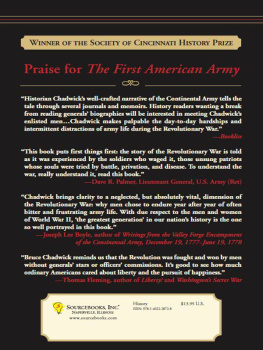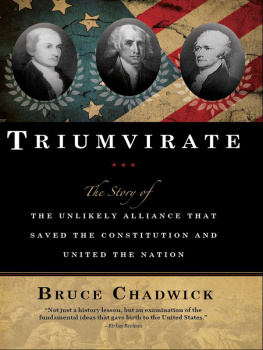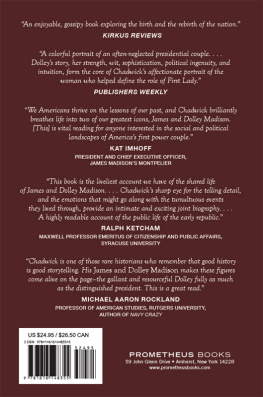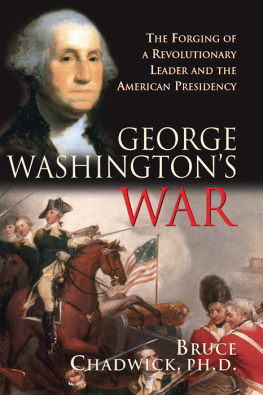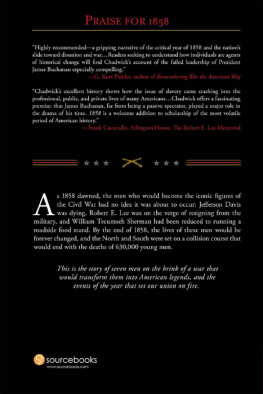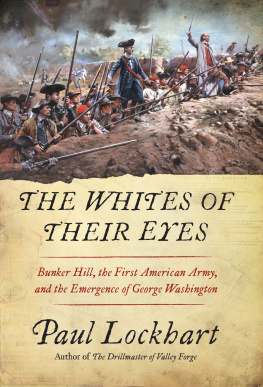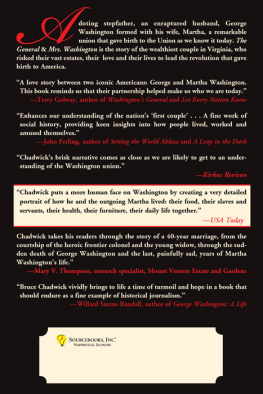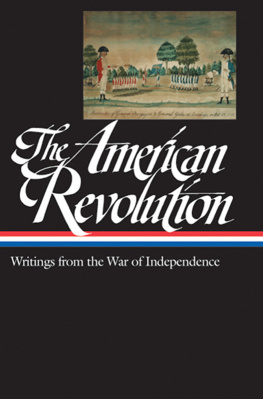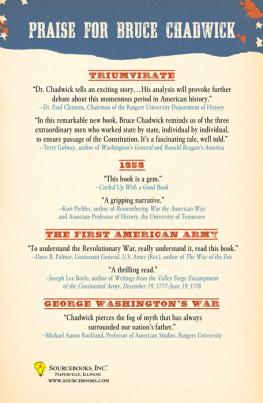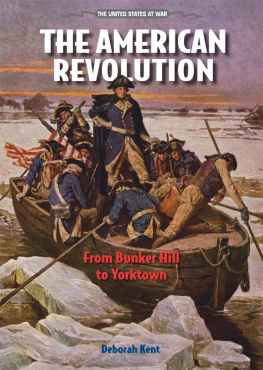THE FIRST AMERICAN ARMY

THE UNTOLD STORY OF GEORGE WASHINGTON AND THE MEN BEHIND AMERICAS FIRST FIGHT FOR FREEDOM
BRUCE CHADWICK, PHD

Also by Bruce Chadwick
George Washingtons War
Brother Against Brother
Two American Presidents
Traveling the Underground Railroad
The Reel Civil War
Bruce Chadwick reminds us that the Revolution was fought and won by men without generals stars or officers commissions. Its good to see how much ordinary Americans cared about liberty and the pursuit of happiness.
Thomas Fleming, author of Liberty! The American Revolution
Although wars are fought by soldiers, they are usually described by historians writing about generals. This book puts first things first: the story of the Revolutionary War is told as it was experienced by the soldiers who waged it, those unsung patriots whose souls were tried by battle, privation, and disease. It is a look through the other end of the telescope, giving new meaning to such words as sacrifice and courage and perseverance. To understand the war, really understand it, read this book.
Dave R. Palmer, Lieutenant General, U.S. Army (Ret), Author of The Way of the Fox, The River and the Rock, Summons of the Trumpet, 1794, First in War, and Washington and Arnold
The First American Army is a most laudable and successful effort to put faces and personalities to some of the men at the knifes edge of the Continental Army. The author tells the stories of some long-forgotten soldiers whose individual achievements might appear small, but collectively comprised our army of independence. Through the use of anecdotes and excellent quotations from the writings of the soldiers themselves, he brings their characters to life and helps appreciate the intense sufferings and also some of the pleasures of life in the army.
Dr. Chadwick brings clarity to a neglected, but absolutely vital, dimension of the Revolutionary War: why men choose to endure year after year of often bitter and frustrating army life. While the desertion rate among patriot soldiers was high, the fact that so many soldiers stayed and did their duty despite poor or non-existent food, clothing, and pay, reflects the remarkable commitment they had to achieving independence. Their steadfast faith and service in the cause never fails to evoke my admiration and respect.
Joseph Lee Boyle, Author of Writings from the Valley Forge Encampment of the Continental Army, December 19, 1777June 19, 1778
Copyright 2007 by Bruce Chadwick
Cover and internal design 2005 by Sourcebooks, Inc.
Cover photo Corbis.
Internal permissions as indicated
Sourcebooks and the colophon are registered trademarks of Sourcebooks, Inc.
All rights reserved. No part of this book may be reproduced in any form or by any electronic or mechanical means including information storage and retrieval systemsexcept in the case of brief quotations embodied in critical articles or reviewswithout permission in writing from its publisher, Sourcebooks, Inc.
Published by Sourcebooks, Inc.
P.O. Box 4410, Naperville, Illinois 60567-4410
(630) 961-3900
FAX: (630) 961-2168
www.sourcebooks.com
The hardcover edition was previously cataloged as:
Library of Congress Cataloging-in-Publication Data
Chadwick, Bruce.
The first American army : the untold story of George Washington and the men behind Americas first fight for freedom / Bruce Chadwick.
p. cm.
Includes bibliographical references and index.
ISBN-13: 978-1-4022-0753-2
1. United States. Continental Army--Military life. 2. Washington, George, 1732-1799. 3. Washington, George, 1732-1799--Friends and associates. 4. Soldiers--United States--Social conditions--18th century. 5. United States--History--Revolution, 1775-1783--Social aspects. I. Title.
E259.C43 2005
973.34--dc22
2005019866
Printed and bound in the United States of America
VP 10 9 8 7 6 5 4 3 2
For the brave men and women in the military forces of the United States of America
The rising world shall sing of us a thousand years to come,
And tell our childrens children the wonders we have done.
song written by a soldier of the Second New York Regiment

AUTHOR TO READER
T he American Revolution may have been highlighted by the inspirational writing of Thomas Paine, the patriotism of the delegates to the Continental Congress, and the leadership of George Washington, but it was won by the enlisted men of the Continental Army over eight years of fighting against one of the greatest military forces in the world. It was not only their bravery under intense fire on battlefields at Trenton, Saratoga, and Yorktown that won the war, but their courage in simply staying together as an army through incredibly severe winters, smallpox epidemics, tattered clothes, and near-starvation that gained independence for America.
There have been many books written about George Washington and other generals in the rebellion and volumes about the key battles of the conflict. There have been lengthy biographies about important political figures of the revolutionary period such as John Adams, Benjamin Franklin, and Thomas Jefferson. But there have been very few works written about the ordinary soldiers of the Continental Army, Americas first army, especially the enlisted men, the original grunts.
The First American Army is an effort to tell the story of the Revolution through the eyes of the common soldiers, not the generals. It is the story of eight men and their travails. Four of themElijah Fisher, John Greenwood, Ebenezer Wild of Massachusetts, and Jeremiah Greenman of Rhode Islandwere enlisted men. I added a lieutenant, Pennsylvanias James McMichael, because he was a poet whose patriotic stanzas added much to the story. I selected a feisty thirty-five-year-old county militia captain, Sylvanus Seely of New Jersey, to explain the role of the militia units. I added a chaplain, the Reverend Ammi Robbins of Connecticut, and a physician, Dr. Lewis Beebe of Massachusetts, so that the reader could understand the spiritual and medical sides of the war.
Finding the men was not easy. Many generals and officers kept journals throughout the war, but few enlisted men wrote down their thoughts for posterity. Most of the enlisted men who did keep journals filled them with rather bland entries (It rained...). Very few infantrymen fought for more than one year, either, and I needed people who spent several years in the army to tell a complete story. I spent a long summer looking for ghosts of the American Revolution. I was lucky and found the extraordinary soldiers whose lives fill these pages. Only the diaries of Greenwood and Greenman were published in book form. Most of the others were published as magazine articles, some over one hundred years ago. Seelys journal was never published.
The book is the chronicle of each mans journey in the army, linked together to tell the overall story of the Revolution. As an example, the reader meets John Greenwood, the fifteen-year-old fifer from Cape Cod, at the battle of Bunker Hill in 1775. Greenwoods life is then recounted throughout the book as the reader encounters the other soldiers as they enter the story. All of the men move in and out of the volume as the history of the war unfolds. We see Greenwood participate in the invasion of Canada in 17751776, riding in a canoe alongside Benedict Arnold. We leave him to meet a remarkable pair of men, Doctor Beebe and Reverend Robbins, who become friends in the middle of the chaotic American retreat from Canada that winter during a terrible smallpox epidemic. We join Greenwood again with George Washingtons army as it crosses the Delaware and makes history. He leaves the story but returns when he decides to fight the war on the high seas, not the battlefield. As he continually departs from the narrative, we pick up other soldiers stories. Jeremiah Greenman, a private from Rhode Island, appears early when he joins the ill-fated invasion of Canada with Greenwood and is taken prisoner and held for nearly a year in Quebec. He comes back again at the bitter battle of Rhode Island in 1778 and in the hard winter of 17791780 at Morristown. The others follow that same revolving pattern.

